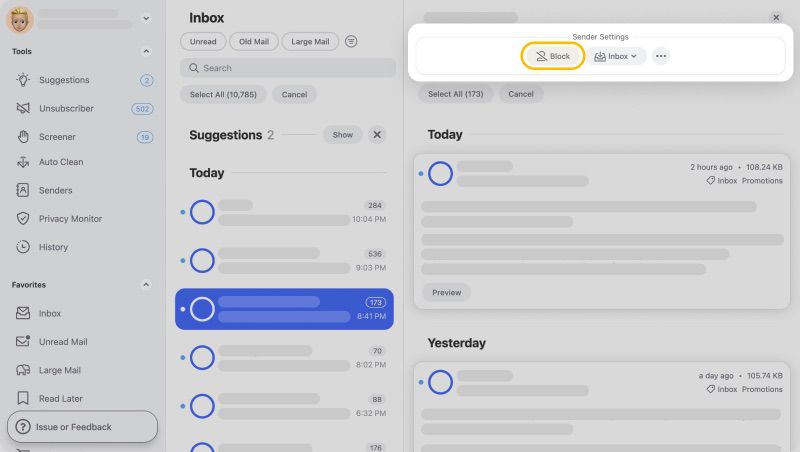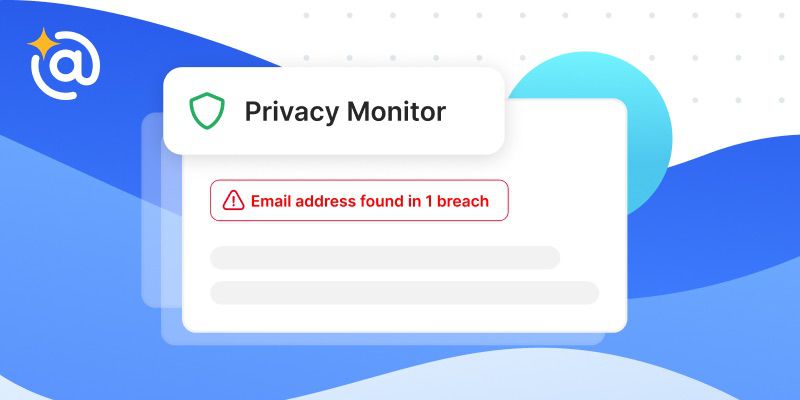
Have you ever received a message that looked as if it was sent by someone you know but was actually sent by someone else? If so, you already know what it’s like to become a victim of email spoofing, and this article is here to explain how to stop email spoofing and keep your inbox organized using Clean Email so that you can easily spot all fake spoofed emails you receive.
What Is Spoofing Email?
Email spoofing is a popular strategy used in spam and phishing emails. It involves the modification of an email header so that the message appears to have been sent by someone else other than the actual sender.
For example, imagine that you’re a Gmail user and receive a message from the following address: support@google.com. Seeing a familiar email address, you open the message and find out that Google needs you to reset your password because someone has been trying to hack your account. Since you have no reason to question the validity of the claim, you click on the included password reset link and reset your password.
The only problem is that the original message wasn’t actually sent by Google. Instead, it was sent by a cybercriminal who used email spoofing to trick you into thinking that they are Google. With your Gmail password, they can now gain access to your online banking, social media, and possibly even other mail accounts.
The reason why it’s so easy to spoof emails is quite simple: email wasn’t originally designed with security and privacy in mind. Instead, it was intended to be an open service run by academics for other academics. It wasn’t until the 1980s when email hosting services had started popping up and the word “email” entered the public lexicon.
How Does Spoofing Differ from Phishing and Spam?
Since all spoofed email messages are unsolicited, they can also be classified as spam. The difference between regular spam and spoofed email messages is that regular spammers don’t edit mail headers to make it appear as if their messages were coming from someone else.
Sure, they do sometimes purposefully use addresses that are almost indistinguishable from mail addresses of legitimate organizations, but they don’t edit them. That said, email spammers and spoofers readily share mail accounts with one another, which is why one of the most effective ways to stop email spoofing is to stay away from shady websites that ask visitors to enter their address.
Okay, but what about phishing? Well, phishing and spoofing are both fraudulent attempts to trick someone into believing that the message they’ve received is from a reputable sender, but phishing takes things a step further.
The ultimate goal of phishers is to induce individuals to reveal personal information, such as passwords and credit card numbers, so they can use this personal information for their own personal gain. To achieve this goal, they sometimes spoof a message by editing its headers using specialized software that makes it possible to create spoof emails without much effort, but spoofing is really just one of several techniques they can use.
The good news is that learning how to spot and stop spoof emails also equips you with the skills and knowledge you need to stop phishing and spam emails.
How to Stop Email Spoofing?
To understand how to stop email spoofing, it’s important to understand that the Simple Mail Transfer Protocol (SMTP), a communication protocol for electronic mail transmission, doesn’t support any form of email authentication. In other words, some other mechanisms must be adopted to prevent email spoofing.
Manually Check Email Headers
Perhaps the simplest way how to identify email spoofing is to manually check email headers.
To read email headers in Gmail
- Open the message you want to check the headers for.
- Click the Down arrow next to Reply.
- Click Show original.

- Copy the text on the page.
You can optionally open the Message header tool and paste your header in “Paste email header here,” to easily identify individual header lines.
To read email headers in Outlook.com
- Open the message you want to check the headers for.
- Click the points of Ellipsis (“…”) next to Reply all.
- Click View message source.

Regardless of which email service you use, you always want to look for the “Return-Path,” which should be the same as the sender’s address. It’s also worth to check the originating IP address and use an IP address lookup tool to find more information about it.
Use Sender Policy Framework (SPF)
The Sender Policy Framework (SPF) is an email authentication mechanism that’s designed to specify which email servers can send emails on behalf of your domain. To implement SPF, domains and hosts need to identify the machines authorized to send a secure email on their behalf by including additional records to their existing DNS information, which is a fairly complicated task that’s best left to experienced network administrators (learn more about how to send an anonymous email).
Recipients can then confirm that the sending IP address is allowed to send emails on behalf of the “envelope from” address of the mail. This confirmation happens before the body of the message is downloaded, making it possible to reject all emails from email spoofers way before they can do any harm.
In addition to SPF, there are several other effective countermeasures against email spoofing, including Sender ID, DKIM, and DMARC. Sender ID tries to improve on SPF by verifying email header fields that all contain sending party information, DKIM verifies if message content is authentic and not changed, and DMARC specifies how domains handle suspicious emails.
Keep Your Inbox Organized
Spoofing email addresses wouldn’t be nearly as effective as it is if people kept their inboxes organized. Unfortunately, that’s easier said than done because about 14.5 billion spam emails are sent every single day. When people receive dozens of emails from unknown addresses on a daily basis, they sooner or later stop paying attention to details, making email spoofing attempts much more likely to succeed.

Even if you don’t have much time to spare on email management, you can still keep your inbox neatly organized by using a smart mailbox organizer like Clean Email, which makes inbox cleaning effortless by organizing your emails into easy-to-review bundles, automatically unsubscribing you from unwanted subscriptions, and allowing you to automate common inbox management tasks with a few simple clicks.

Here’s how easy it is to block a malicious sender with this app to stop spoofing emails from reaching your inbox:
- Go to: https://app.clean.email/
- Sign in with your mail address.
- Go to your Inbox and select any message from the sender you want to block.
- Click the Block button in the toolbar to automatically move all existing and new emails matching the rule to Trash.

Alternatively, you can click the Spam button instead and choose to mark as spam the selected and future similar emails. Regardless of which approach you choose, Clean Email will always reliably stop all messages coming from the spoofed email address, preventing them from tricking you into performing an action you wouldn’t want to perform if you knew the real person behind the spoofed email sender address.
Privacy Guard from Clean Email is a wonderful option to keep your identity safe and your personal information private. Privacy Guard has real-time data about security breaches and will check if your email account’s credentials were compromised. All you need to do is to launch Clean Email, choose the “Privacy Guard” feature on the left panel of the home screen, and perform the check.

Once checked, you will be notified if your account was found in any data breaches and if you need to take any security measures. To protect your mail account on a higher level, you can enable multi-factor authentication, change passwords from time to time, etc. With Privacy Guard you can be assured that your credentials are safe and protected.
Clean Email works with all secure email providers that use the Internet Message Access Protocol (IMAP) to retrieve email messages from a mail server, which includes Gmail, Outlook, Yahoo Mail, Fastmail, AOL, and many others. Why make it easier for email spoofers to trick you when keeping your inbox organized can be such an easy and effective email spoofing prevention method?
Wondering how to protect your emails and make sure that legitimate messages don’t get to spam? Check out our guides on how to back up emails and how to whitelist an email.
Conclusion
Email spoofing is a surprisingly effective strategy that many cybercriminals like to use when trying to obtain sensitive information by disguising oneself as a trustworthy entity in an electronic communication. The good news is that there are many things that you can do to prevent email spoofing, and it can be as easy as keeping your inbox organized using Clean Email, a bulk email management tool with clever automation features that empower you to take greater control of your inbox.